全文HTML
--> --> -->流注整体形似手指状, 包括类似于皇冠状的流注头部以及流注等离子体通道构成, 其头部存在一个高度集中的空间电荷壳层, 这部分空间电荷会极大地提高其前方非电离区域的电场, 同时抑制其内部通道的电场. 流注在空气中较容易产生, 当高电压施加在一个尖电极上, 其附近电场会超过有效电离临界阈值, 自由电子将在高电场区域中加速并由于碰撞电离而产生更多电子[6]. 流注进一步发展的前提是前方有自由电子(也称为种子电子)存在, 它们有多种来源, 如激光等人工电离源、前序放电剩余的电离、或是流注头部的光电离作用等[7-10]. 研究表明空气中流注自身的光电离是最重要的自由电子来源机制, 流注头部活跃的电离区域会发出光辐射, 这种辐射主要源自激发态氮气, 导致其前方氧气分子电离产生电子[11]. 这部分电子在朝流注头部运动的过程中由于碰撞电离产生二次电子崩, 支持流注继续发展.
分支现象是流注在发展过程中最重要的一个特点, 典型分支图像如图1所示[12]. 流注发展Lichtenberg图第一次清晰地记录了其树枝状结构特征[13]. 从大量微秒级曝光时间的流注照片中可以发现其具有大量的分支的树形结构, 随着曝光时间减少到几纳秒, 流注在增强电荷耦合器件(ICCD)照片中呈现多个分散孤立的圆形斑[14]. 当一个流注头部分成了两个流注时, Chen等[15,16]通过多分幅ICCD相机捕捉流注分支的精细过程. 研究者提出了不同流注分支机理, 传统理论认为流注前方不同处光电离提供的种子电子往回发展的电子崩形成了新的流注分支[6]. Liu和Pasko[10]提出了一个分支判据, 认为当光电离最小吸收距离小于流注半径时流注发生分支. 但是对于单个流注发生多次分支情况无法得到解释, 流注半径在分支后逐渐减小, 按照此判据分支临界半径不变. Pancheshnyi[8]研究了光电离和背景预电离对种子电子的影响, 发现种子电子的随机分布可能是分支的原因. Luque和Ebert[17]研究解释了流注头部电子密度的随机波动导致流注分支. 文献[18]也提出了更为实用的正流注分支判据, 流注分支概率与流注头部区域光电离速率相关. 为了验证分支机理, 文献[12, 19—21]研究了不同氮气氧气比例的混合气体中流注分支特性, 包括分支角度、分支前后的横截面积以及流注长度和直径之间的比率(分支率). 研究发现在空气中分支率为11 ± 4, 纯度为99.9%氮气中降至9 ± 3[19]. 当氧浓度降低到0.01%时, 分支率急剧下降[12]. 氮气-氧气比直接决定了流注头部光电离的种子电子产生速率, 间接反映了光电离速率和流注分支特性之间的关系. 由于该实验是新分支判据的间接证据, 暂缺乏直接实验证据来验证. 这是由于空气中直接用紫外波段激光进行照射会产生大量其他的粒子, 无法有效排除它们的影响; 并且光电离的极紫外光在较短距离内会被氧气分子吸收, 无法直接改变光电离速率进行实验. 因此我们利用数值模型来揭示流注分支的机理.
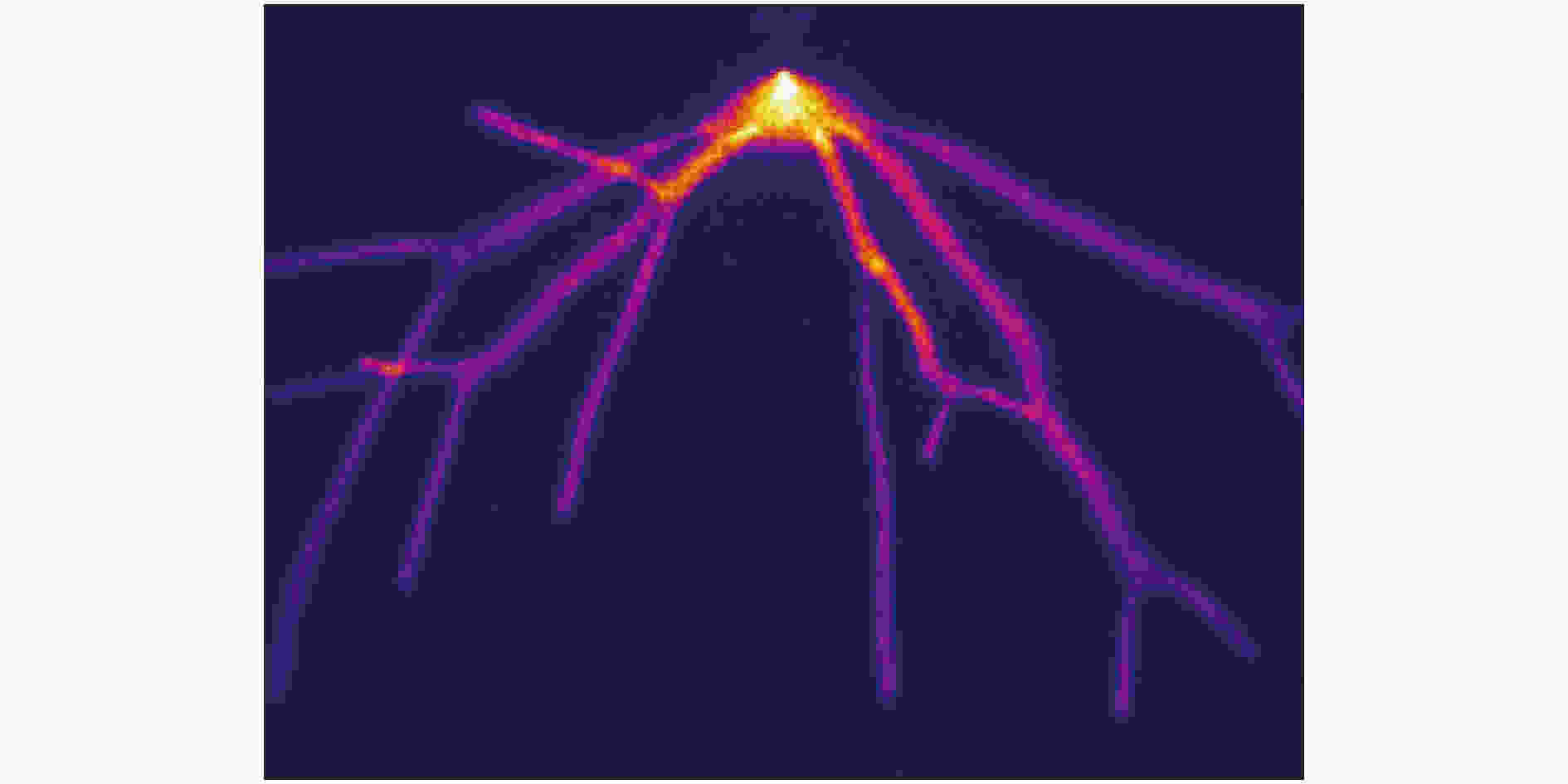 图 1 合成空气中流注放电分支图像(气压100 mbar (1 bar = 105 Pa), 16 cm尖-板间隙, 脉冲电压幅值为10 kV)[12]
图 1 合成空气中流注放电分支图像(气压100 mbar (1 bar = 105 Pa), 16 cm尖-板间隙, 脉冲电压幅值为10 kV)[12]Figure1. Branching structure of streamer discharges in synthetic air (the air pressure is 100 mbar; 16 cm point-plane gap, pulse voltage amplitude 10 kV)[12].
流注数值仿真模型随着计算机性能的增强以及先进算法的引入取得了重大的进步. ****提出了三类基本流注放电模型: 流体力学模型、动力学模型和混合动力学-流体模型. 流注存在固有的三维空间结构, 文献[8, 22—25]进行了三维模型仿真, 得到了背景电离、电极非对称布置和不同类型放电的不稳定性对流注分支的影响. 由于流体模型对带电粒子的效应进行了流体近似处理, 因此结果不如利用粒子网格单元与蒙特卡罗碰撞相结合(PIC-MCC)的三维模型计算准确. PIC-MCC给出了空间电荷区域的粒子的动力学描述, 针对等离子体中多尺度问题, 特别是其中有小区域的大梯度系统尤其有效. Chanrion和Neubert[26]实现了低气压下的流注放电动力学仿真, 该模型可以模拟从单个自由电子演变到电子雪崩及向流注过渡的整个物理过程, 暂未涉及流注分支现象. Teunissen和Ebert[27]提出了一种使用k-d树的新的粒子管理算法和并行计算, 实现了流注分支的快速仿真, 仿真了电离云迸发多个流注过程. 孙安邦等[28,29]采用自适应可变网格以及粒子可变权重技术, 仿真了不同电压、气压和曲率半径电极上流注放电的起始以及分支过程, 讨论了分支结构和数目的变化情况. PIC-MCC模型从等离子体物理的粒子性质的角度出发可考虑各种随机源项, 因此, 它是流注分支研究的理想选择.
本文使用三维PIC-MCC模型研究大气压下氮气-氧气混合气体中流注分支机理, 仿真了毫米短间隙流注发展及分支的物理过程. 为了验证流注头部光电离速率和流注分支之间的关系, 弥补实验无法直接调控光电离速率的不足, 通过改变氮气-氧气比例、氧气吸收光子截面系数以及光电离效率系数来研究这些因素对流注分支的影响, 与实验结果对比分析, 揭示当光电离速率降低时空气中正流注分支呈现出更大概率的机理.
随着计算机硬件的高速发展以及并行计算的应用, Pamdi3D优化以往常规的数值程序框架, 发挥了并行计算优势, 大大缩短了仿真时间. 由于计算机内存的限制, 无法存储大量电子(108—109)的状态. 为了进一步提高计算效率, Pamdi3D采用了自适应粒子管理算法. 一方面可以在不大幅降低精确性的前提下对相似状态的粒子数合并成超粒子(super particle), 每个粒子代表许多粒子的集合, 保证合并前后粒子的总质量、动量和能量守恒; 另一方面重新划分粒子分布区域可以使得较高计算精度的区域粒子数减小, 而较低计算精度区域粒子数增多, 平衡整个网格粒子计算负载.
Zheleznyak等[11]研究了氮气-氧气中光电离机制, 光子来源主要是激发态的氮气向基态转变时辐射出的光子, 并使氧气电离, 具体反应途径如(1)式所示:
在Zheleznyak的光电离模型中, 电离氧气分子的光子产生速率与氮气电离速率成正比. 相对速率ψ为单次碰撞电离产生的氧气分子电离数:
在本模型引入了随机光电离源项, 并非以往确定性的模型, 每个网格点所在粒子以一定概率发生光电离. 文献[26]中首次建立了一个随机粒子版本光电离模型, 本文模型与其区别在于修正了光电离效率系数关于约化场强的取值. 当随机数R1 < ψ时, 即认为氮气分子电离时产生了一个光子. 可以使氧气分子电离的光子频率在ν1 = 2.93 × 1015 Hz和ν2 = 3.06 × 1015 Hz之间, 光子频率也决定了光子的平均自由程. 由随机数R2可以确定光子频率:








本次模拟的基本条件为: 一个大气压, 温度为293 K, 气体组分为一定比例的氮气和氧气的混合气体. 为了模拟干燥空气, 氮气和氧气的浓度分别为80%和20%. 整个仿真空间为8.32 mm × 8.32 mm × 8.32 mm立方体区域. 在此区域中, 杆电极安装有尖端, 尖端为圆锥, 高0.5 mm, 底面直径0.5 mm, 端部曲率半径为0.05 mm, 仿真间隙布置如图2所示.
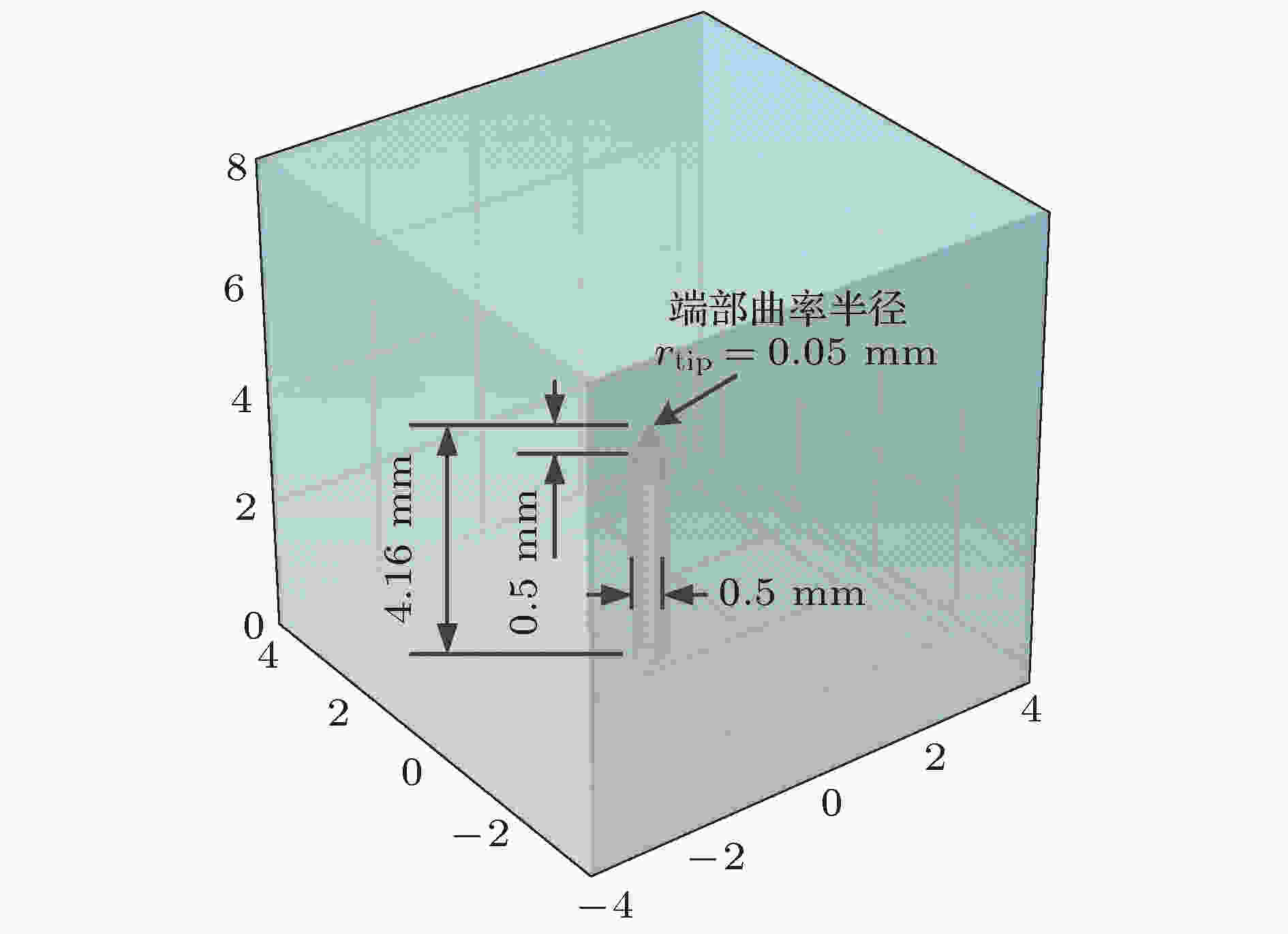 图 2 间隙布置示意图
图 2 间隙布置示意图Figure2. Schematic diagram of electrode arrangement.
网格长度Δx的选取应该与Debye长度λD数量级一致, Debye长度反映了等离子体的电荷屏蔽效应, 当Debye长度小于网格尺寸时, 可认为等离子体呈电中性.




对于时间步长Δt的选取也应满足Courant-Friedrichs-Lewy (CFL)收敛条件:
电极上施加 + 3.5 kV, 周围边界的电势均为零. 初始尖端附近有一团电子-正离子对, 在尖端为中点呈三维高斯分布, 标准差σ为100 μm, 电子初始能量为0.1 eV, 仿真时间步长为最短为10–3 ns. 在服务器(CPU为12核主频2.2 GHz英特尔至强E5-2430, 内存为32 GB)上进行计算, 综合考虑流注分支情况与仿真耗时后总时长取为10 ns左右, 完成单次计算约需6 d.
2
3.1.氮气-氧气比例对流注分支的影响
首先改变氮气和氧气的比例, 光电离速率随着氮氧气体比例变化而改变. 当氧气浓度由20%减少至1%时, 氮气浓度变化不大, 被光子电离产生电子的氧气浓度减小了一个数量级, 因此光电离速率减小; 相似地, 当氧气浓度由20%增大至99%时, 由于氮气浓度变化了一个数量级, 提供电离的光子数大幅减小, 光电离速率也减小. 综上分析, 仿真研究了氮气-氧气比例分别为80% : 20%, 99% : 1%以及1% : 99%下流注发展情况. t = 9 ns时不同的氮气-氧气比例下流注电子密度的三维仿真结果见图3. 图中大于2.0 × 1019 m–3的电子密度区域是不透明的, 并且当密度降低时其显示的透明度增加. 在三种条件下, 所有流注都呈现有分支现象, 尤其在1% : 99%的氮气-氧气中特别清楚. 图 3 不同氮气-氧气比例下流注电子密度三维仿真结果(t = 9 ns) (a) 80% : 20%; (b) 99% : 1%; (c) 1% : 99%
图 3 不同氮气-氧气比例下流注电子密度三维仿真结果(t = 9 ns) (a) 80% : 20%; (b) 99% : 1%; (c) 1% : 99%Figure3. Three-dimensional simulation results of electron density at t = 9 ns for different nitrogen-oxygen ratio: (a) 80% : 20%; (b) 99% : 1%; (c) 1% : 99%.
图4为三种情况下通过针尖对称轴平面上的电子数密度和电场强度在不同时刻的变化趋势. 图4(a)中流注最大场强位置离尖端1.4 mm, 流注头部电荷层在9 ns开始出现断续情况, 代表流注此时将要发展出分支; 而对于另外两种氮气-氧气比例, 图4(b)和图4(c)流注在6.0 ns时刻已经开始分支, 并且对于氮气-氧气比例1%和99%情况, 流注头部出现多个分支, 而不是像氮气-氧气比例99%和1%情况仅有两个分支. 由上述仿真结果可知, 改变氮气-氧气浓度间接地影响光电离的效率, 降低氧气浓度后会更早引发流注分支, 也进一步证实分支机理, 减小光电离速率会加速分支.
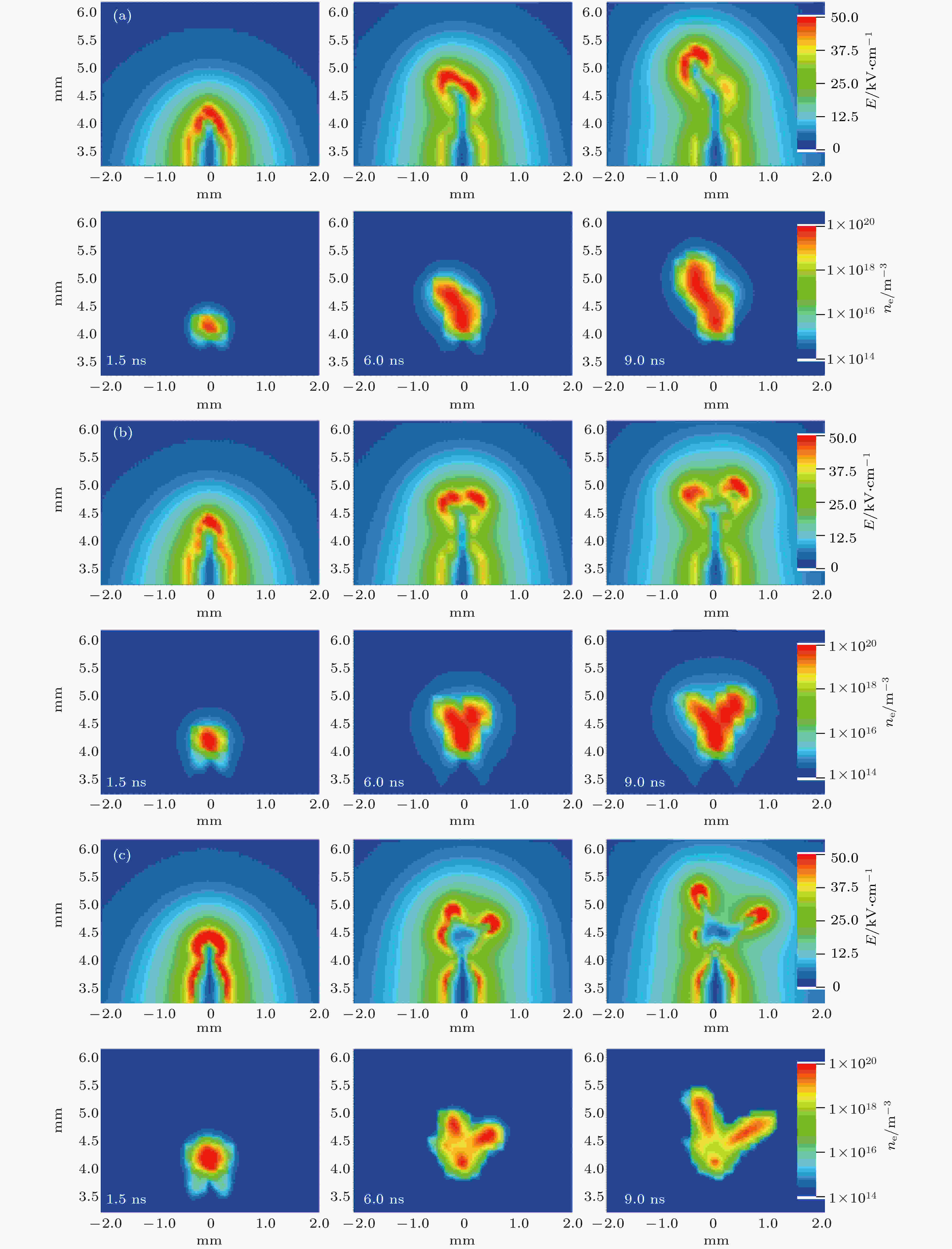 图 4 不同氮气-氧气比例下流注发展仿真结果对比 (a) 80% : 20%; (b) 99% : 1%; (c) 1% : 99%
图 4 不同氮气-氧气比例下流注发展仿真结果对比 (a) 80% : 20%; (b) 99% : 1%; (c) 1% : 99%Figure4. Electron density and electric field in simulated region at different moments. It shows the comparison of streamer branching results for different nitrogen-oxygen ratio: (a) 80% : 20%; (b) 99% : 1%; (c) 1% : 99%.
2
3.2.氧气吸收光子电离截面系数的影响
根据氧气中光电离的光谱研究, 电离氧气的最大辐射光波长为1025 ?. 增大光电离碰撞截面系数, 等效于减小光电离吸收平均自由程, 理论上可以增大流注头部同等距离区域内光电离产生电子数量, Zheleznyak光电离模型中最小氧气吸收光电离截面系数χmin = 0.035 Torr–1·cm–1 (1 Torr = 1.33322 × 102 Pa), 人为地将此截面系数减小1/10以及放大20倍, 取χmin = 0.0035 Torr–1·cm–1和0.7 Torr–1·cm–1, 对比两种情况下流注发展情况, 图5为通过针尖对称轴平面上的电子数密度和电场强度在不同时刻的变化趋势.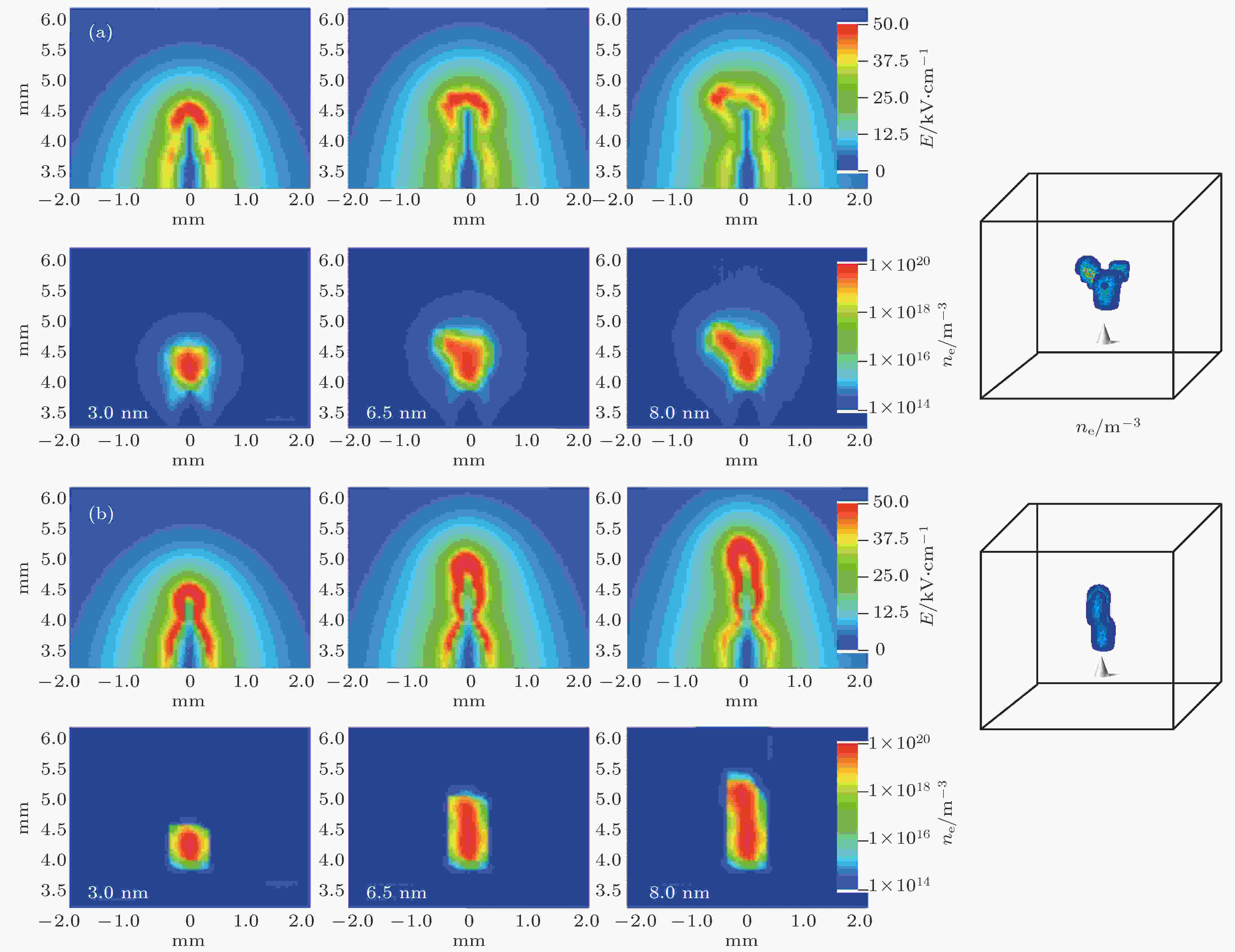 图 5 不同氧气吸收光子电离截面下流注发展 (a) χmin = 0.0035 Torr–1·cm–1; (b) χmin = 0.7 Torr–1·cm–1
图 5 不同氧气吸收光子电离截面下流注发展 (a) χmin = 0.0035 Torr–1·cm–1; (b) χmin = 0.7 Torr–1·cm–1Figure5. Electron density and electric field in simulated region at different moments. It shows the comparison of streamerbranching results for different absorption cross sections: (a) χmin = 0.0035 Torr–1·cm–1; (b) χmin = 0.7 Torr–1·cm–1.
当χmin = 0.0035 Torr–1·cm–1时, 图5(a)中流注在6.5 ns时仍没有显著流注分支生成, 直到8 ns时流注头部在两个地方有局部强场区域, 且其中一个为主要分支发展方向, 开始发生分支; 但是增大χmin后, 如图5(b)所示, 到8 ns时流注头部离尖端1.5 mm, 流注发展稳定还未发生分支, 流注发展的速度在增大光吸收截面系数后也有所增快. 对比两个仿真结果, 可知当增大氧气吸收光子电离截面系数后, 流注更难发生分支, 这也从侧面印证了分支机理的猜想.
2
3.3.光电离效率系数的影响
以上两小节均是通过间接改变光电离参数探寻光电离速率对于分支的影响, 本小节直接改变光电离效率系数来研究其影响. 光电离效率的系数PIeff表达式如(8)式所示, 它的物理含义为不考虑激发态氮气分子猝灭(quenching)情况下, 激发态氮气分子中能辐射有效电离光电子的效率.



 图 6 光电离效率系数关于约化场强的取值
图 6 光电离效率系数关于约化场强的取值Figure6. Photoionization efficiency coefficient as a function of reduced electric field.
我们仿真对比了1/10和2倍

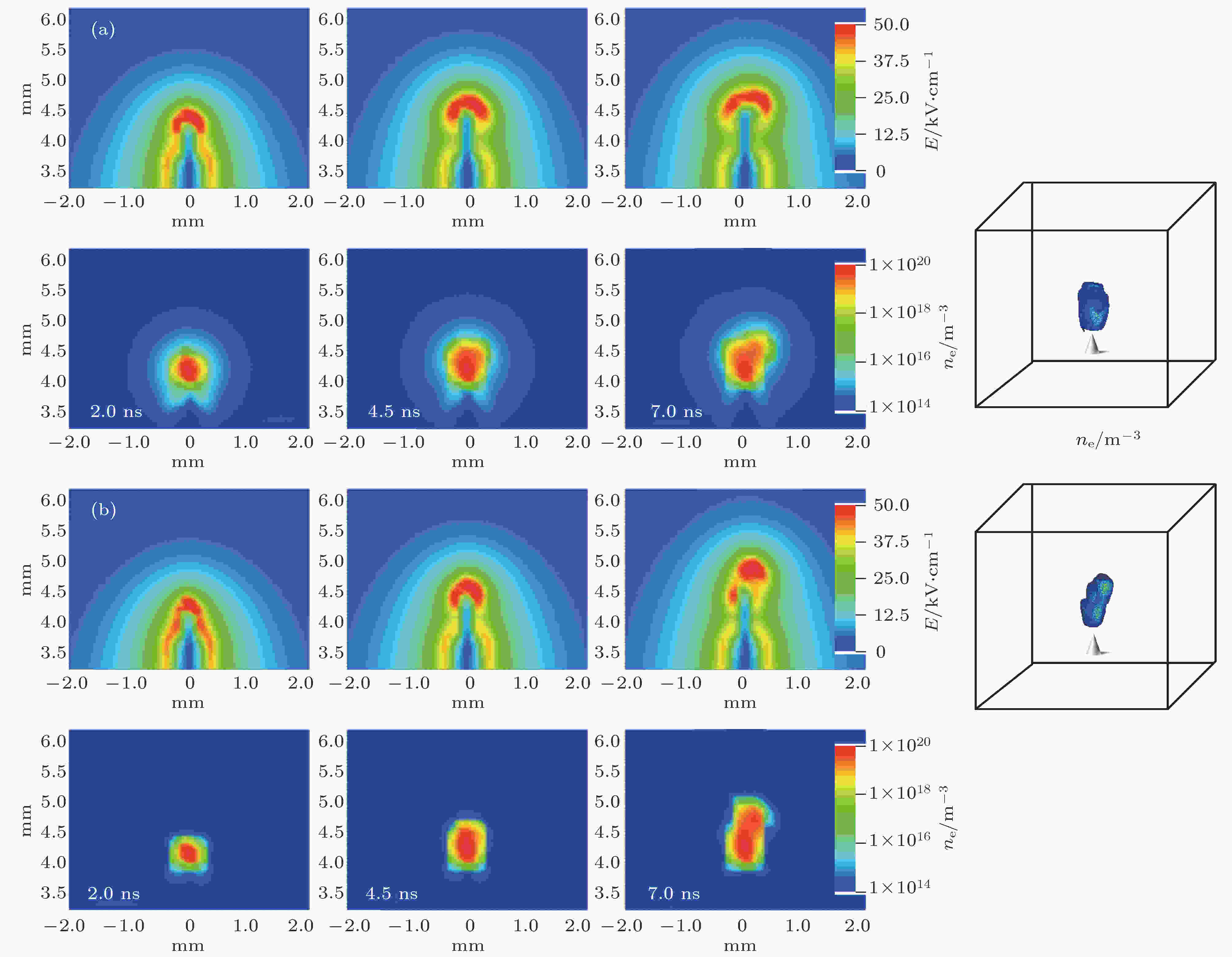 图 7 不同光电离效率系数下流注发展仿真结果对比 (a) 2
图 7 不同光电离效率系数下流注发展仿真结果对比 (a) 2



Figure7. Electron density and electric field in simulated region at different moments. It shows the comparison of streamer branching results for different photoionization efficiency coefficient: (a) 2




在单个流注发展的过程中, 非均匀电场下流注头部强场区域的光电离活动会逐渐减弱. 当光电离产生较多光电子时不容易受内在分布随机波动的影响, 但是当光电离速率减小时就容易引发某个局部的电子崩随机占优发展, 从而产生较强的空间电荷场, 造成流注头部本来存在的狭窄的空间电荷区域不稳定而出现新的流注分支. 本研究通过直接改变光电离速率揭示了此分支机理. 当流注发展中人为增大光电离加速种子电子产生后, 流注分支情况被抑制. 上述分支机理是从数值试验推理得到的, 还有试验从侧面进一步说明流注头部附近的自由电子分布会影响分支的产生. Nijdam等[7]利用KrF激光源局部照射氩气中发展的正流注, 研究激光产生的背景电离如何影响流注特性. 当局部区域激光产生的背景电子数密度达到约5 × 105 cm–3时, 流注的分支被抑制, 且此区域随着激光照射位置的移动而变化. 这个试验现象直接说明了流注发展时其头部前方自由电子数密度越大, 越容易抑制流注发生分支.
结合以往的流注分支理论和本文仿真结果, 无论是由光电离产生种子电子还是预先存在背景电离中的电子, 当电子数密度大于某个阈值时, 流注较难发生分支. 当不考虑背景电离因素而只考虑流注本身光电离作用时, 可以推导出当流注头部区域光电离速率低于某个阈值时, 越容易引发流注发生分支.
这个机制可以较好地定性文献[18]的试验结果. 非均匀电场中, 当流注朝远处发展时, 头部附近的场强会逐渐减弱, 与此同时光电离速率也随之减小, 当其减弱到一定程度时, 随机波动导致局部种子电子数密度分布不均匀, 导致某个区域电子崩发展到一定数量影响流注头部空间电荷层, 从而造成此区域发生不稳定, 流注发生分支; 分支以后, 由于流注的直径减小, 流注发展一段时间后其头部的电场再次得到增大, 因此光电离速率也随之升高, 直至进一步在弱电场中发展导致其光电离速率下降而引发下一次分支.
